THE PHILIPPINES’ growth momentum remains “broadly stable,” even as global trade tensions would make it hard to hit the 6-8% growth target in the next two years, an Organisation for Economic Co-operation and Development (OECD) economist said.
“The Philippines continues to show very solid growth momentum, supported by domestic demand and somewhat by public investment,” OECD economist Cyrille Schwellnus said at a briefing on Wednesday.
In its latest Economic Outlook, the OECD projected below-target growth for the Philippines for 2025 and 2026. It sees the Philippine economy growing by 5.6% this year, and picking up to 6% in 2026.
Mr. Schwellnus cited robust labor market and election-tied expenditure as main drivers of growth.
“But investment is going through a soft patch, growing well below its average over the past three years. Exports, again, are growing at a healthy pace. But we expect that to weaken on the back of escalating global trade tensions,” he said.
In April, the US slapped higher reciprocal tariffs on most of its trading partners’ goods exports, though this has been suspended until July, except for the baseline 10% which still remains in effect. The US slapped the Philippines with a 17% reciprocal tariff, the second lowest among its neighbors.
Mr. Schwellnus said the government’s 6-8% growth target is “perfectly attainable” in the medium term.
“But in the very short term, in 2025, 2026, we see [the target] as difficult to reach,” Mr. Schwellnus said.
In the first quarter, gross domestic product (GDP) grew by a weaker-than-expected 5.4% amid heightened uncertainty arising from the Trump administration’s tariff policies.
“Now in 2025, we have additional headwinds, especially from the external side, so a slowdown of global trade, but also on the domestic side, where we see some fiscal consolidation going on over the next couple of years,” Mr. Schwellnus said.
The OECD cut its global growth outlook to 2.9% in both 2025 and 2026, noting that “substantial barriers to trade, tighter financial conditions, diminishing confidence and heightened policy uncertainty are projected to have adverse impacts on growth.”
The OECD noted the possible impact of the global economic slowdown on remittances from overseas Filipino workers.
“If there were to be a larger-than-expected slowdown in major economies, such as the US or China, that would, of course, have an effect on exports of the Philippines, and it might also impact remittance flows, which would then impact domestic consumption and investment,” Mr. Schwellnus said.
However, the OECD said the impact on remittance flows was not accounted for in its growth projection for the Philippines.
Mr. Schwellnus said the Philippines can immediately implement reforms, especially to reduce barriers to foreign direct investment.
In the same report, the OECD projected that inflation would settle at 2% this year and 3.1% in 2026 “amid balanced domestic demand and currency stability.”
“Looking ahead, we expect inflation to gradually return to 3% as food prices stabilize and monetary policy continues to ease,” he said.
BSP Governor Eli M. Remolona, Jr. earlier said cooling inflation has given them “plenty of room” to cut rates this year. Mr. Remolona said they could deliver two more rate cuts this year, in “baby steps” of 25 basis points.
SERVICES UNAFFECTEDMeanwhile, the Philippines’ services sector is unlikely to be impacted by the US tariff policies, S&P Global Ratings said, though the industry could eventually face strains in the coming years.
“In the Philippines, the story is more nuanced. The Philippines is active in the export of certain things. One is services, especially business process outsourcing. It is a big factor for the Philippine economy,” S&P Global Ratings Senior Economist Vishrut Rana said in a webinar.
The service sector will likely be sheltered from the initial impact of the trade tensions, he said.
“One element of shelter is that for services. Trade seems to be unaffected by the tariff measures for the time being. It could come under pressure over the next few years,” he added.
United States President Donald J. Trump’s reciprocal tariffs have only covered goods, not services.
Meanwhile, the credit rater also noted that the Philippines’ electronics exports are also spared for the time being.
“The Philippines is also a significant player in the electronic supply chain in Asia and the Pacific (APAC). However, for the time being, it doesn’t seem to be a focus area,” Mr. Rana said.
The US’ reciprocal tariffs will not apply to certain goods, such as semiconductors, copper, pharmaceuticals, gold, and minerals that are not available in the US, according to the White House’s April 2 tariff announcement.
Electronic products were the top commodity export of the Philippines last year, accounting for more than half or 53.4% of its total exports.
“On broader trade, there could be some pressure on the electronic space. We are watching that at the moment,” Mr. Rana said. “For now, the APAC electronic sector is performing relatively well, which is supporting the sector in the Philippines also.” — ARAI and LMJCJ






